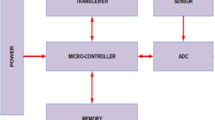Abstract
We study the dynamics of virus spread in wireless sensor networks (WSNs). We first analyze the susceptible-infective (SI) epidemic model for WSNs. In the SI model, once a sensor node is attacked by a virus, the infective node then, using normal communications, spreads the virus to its neighboring nodes, which further spread the virus to their neighbors, the process continues until the whole network fails. To combat this drawback, we propose a modified SI model by leveraging the sleep mode of WSNs to perform system maintenance. The modified SI model can improve the network anti-virus capability and flexibly adapt to different types of virus, without causing any additional hardware effort and signaling overhead. We derive the explicit analytical solutions for the modified SI model, which can capture both the spatial and temporal dynamics of the virus spread process. Extensive numerical results are presented to validate our analysis. The proposed model and analysis method are expected to be used for analysis and design of information (including virus) propagation mechanisms in distributed wireless or computer networks.







Similar content being viewed by others
References
S. Tang and W. Li, Qos supporting and optimal energy allocation for a cluster-based wireless sensor network, Elsevier Computer Communications, Vol. 29, pp. 2569–2577, 2006.
D. Yupho and J. Kabara, The effect of physical topology on wireless sensor network lifetime, Journal of Networks, Vol. 2, pp. 14–23, 2007.
N. A. Pantazisa, D. J. Vergadosb, D. D. Vergadosa, and C. Douligeris, Energy efficiency in wireless sensor networks using sleep mode TDMA scheduling, Ad Hoc Networks, Vol. 7, pp. 322–343, 2009.
P. Ferrie, P. Szor, R. Stanev, and R. Mouritzen, Security responses: Symbos.cabir, tech. rep., Symantec Corporation, 2004.
E. Chien, Security response: Symbos.mabir, tech. rep., Symantec Corporation, 2005.
J.-L. Sanders, Quantitative guidelines for communicable disease control programs, Biometrics, Vol. 27, pp. 883–893, 1971.
H. W. Hethcote, An immunization model for a heterogeneous population, Theoretical Population Biology, Vol. 14, pp. 338–349, 1978.
R. Pastor-Satorras and A. Vespignani, Epidemic spreading in scale-free networks, Physical Review Letters, Vol. 86, pp. 3200–3203, 2001.
M. E. J. Newman, Spread of epidemic disease on networks, Physical Review E, Vol. 66, pp. 1–11, 2002.
Y. Moreno, M. Nekovee, and A. Vespignani, EfficiLency and reliability of epidemic data dissemination in complex networks, Physical Review E, Vol. 69, pp. 1–4, 2004.
A. Khelil, C. Becker, J. Tian, and K. Rothermel, Directed-graph epidemiological models of computer viruses. In Proc. 5th ACM Int’l Workshop on Modeling Analysis and Simulation of Wireless and Mobile Systems, pp. 54–60, 2002.
J. W. Mickens and B. D. Noble, Modeling epidemic spreading in mobile environments. In Proc. 4th ACM Workshop on Wireless Security (WiSe’05), Cologne, Germany, pp. 77–86, 2005.
S. A. Khayam and H. Radha, A topologically-aware worm propagation model for wireless sensor networks. In Proc. 2nd Int’l Workshop on Security in Distributed Computing Systems, pp. 210–216, 2005.
H. Zheng, D. Li, and Z. Gao, An epidemic model of mobile phone virus. In 1st Int’l Symposium on Pervasive Computing and Applications, pp. 1–5, Aug. 2006.
P. De, Y. Liu, and S. K. Das, An epidemic theoretic framework for evaluating broadcast protocols in wireless sensor networks. In Proc. IEEE Int’l Conf. on Mobile Adhoc and Sensor Systems (MASS), Pisa, Italy, Oct. 2007.
S. K. Tan and A. Munro, Adaptive probabilistic epidemic protocol for wireless sensor networks in an urban environment. In Proc. 16th International Conference on Computer Communications and Networks (ICCCN 2007), pp. 1105–1110, Aug. 2007.
R. M. Anderson and R. M. May, Infectious Diseases of Human: Dynamics and Control. Oxford University Press, Oxford, 1991.
J. W. Hui and D. Culler, The dynamic behavior of a data dissemination protocol for network programming at scale. In Proc. 2nd International Conference on Embedded Networked Sensor Systems, Baltimore, MD, pp. 81–94, Nov. 2004.
S. Boyd, A. Ghosh, B. Prabhakar, and D. Shah, Gossip algorithms: design, analysis and applications. In Proc. IEEE INFOCOM’05, Miami, FL, Mar. 2005.
Author information
Authors and Affiliations
Corresponding author
Rights and permissions
About this article
Cite this article
Tang, S. A Modified SI Epidemic Model for Combating Virus Spread in Wireless Sensor Networks. Int J Wireless Inf Networks 18, 319–326 (2011). https://doi.org/10.1007/s10776-011-0147-z
Received:
Accepted:
Published:
Issue Date:
DOI: https://doi.org/10.1007/s10776-011-0147-z




